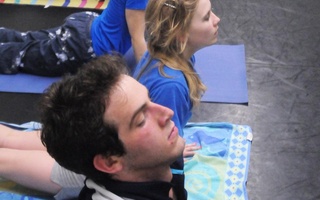BOSTON--Yesterday, youths and adults alike took time out of their weekend to stop to smell the flowers.
Just as you don't normally find older couples romping around the halls of Boston's Children's Museum, there usually aren't that many younger children studying the paintings on the walls of Boston's Museum of Fine Arts.
But yesterday during its annual Lilac Sunday, the Arnold Arboretum had it all.
Whether they came to celebrate the purple and white blossoms by comparing the number of petals of various Syringa species or by rolling down hills covered with dandelions, the roughly 20,000 people who packed Harvard's botanical museum/lab all came to smell the flowers.
Although the Arboretum has numerous other exquisite collections, Chief Plant Propagator, John H. Alexander III, said that these redolent spring blossoms have a certain nostalgia attached to them.
"A lot of people think of lilacs as the plant that was at [their] grandmother's back door," Alexander said.
Most lilac lovers yesterday said that they had made the century-old event into something of a family tradition.
Although Marliene and Marvin Miller could not remember exactly how long they had been coming to Lilac Sunday, they joked that it was probably a little less than 300 years.
The two Newton residents added that although they were especially impressed by the blossoms this year, they were a little bit overwhelmed by the crowd.
"It's a good one alright, but it's better to come on Saturday before the whole crowd shows up," Marliene Miller said.
Alexander said that while he and his colleagues do not know exactly what makes one year better than the next, they do have very refined methods to produce a better plant.
The bearded propagator, dressed for the occasion in a lilac purple T-shirt emblazoned with a Harvard shield where the word "Veritas" was replaced with "Syringa," said that most of the Arboretum's lilac plants are "cultivars,"--bred for their various horticultural merits.
Alexander said that among the qualities to look for in a good lilac are a strong fragrance, abundance of flowers, well displayed flowers and resistance to disease.
Although there are numerous varieties, Alexander said that lilacs come from two main species: Syringa Vulgaris, a variety which originates in Bulgaria, Yugoslavia and Romania, and Syringa Oblata which has its roots in the Korean Peninsula. This spring's record blizzard left the more than 600 small shrub-like lilac bushes virtually untouched, whereas many of the arboretum's larger trees suffered serious damage. Yesterday the park's paths were littered with broken branches. Of the 1,736 trees and plants hurt by the storm, 313 must be removed and 599 suffered major damage. Most heavily damaged were conifers like white pines, hemlocks, arborvitaes and Scots pines. In addition to Lilac Day, the Arboretum has an annual plant sale later in the year where some lilacs are sold. Designed in 1872 by Frederick Law Olmsted and planted by Charles S. Sargent, the Arboretum is Harvard's "living museum" for scientific study and public use. It is located near the Orange Line's Forest Hill stop
Read more in News
Officials Find H-R Groups Want More CoordinationRecommended Articles
-
Sleeping Beauty in Good Shape Even After 100 YearsThe Sleeping Beauty The Boston Ballet at the Wang Center through November 7 At the opening of the Boston Ballet's
-
 Get Out! Health
Get Out! Health -
 Seeing Old With New: Digital Push Begins in Harvard's Art Museums
Seeing Old With New: Digital Push Begins in Harvard's Art Museums -
 Engagement: Anthony J. Staccone ’13 and Anika R. Petach ’13
Engagement: Anthony J. Staccone ’13 and Anika R. Petach ’13 -
 Get Out: Arnold Arboretum
Get Out: Arnold Arboretum -
 Rebuilding the Past: Harvard's Beautification Renaissance
Rebuilding the Past: Harvard's Beautification Renaissance













